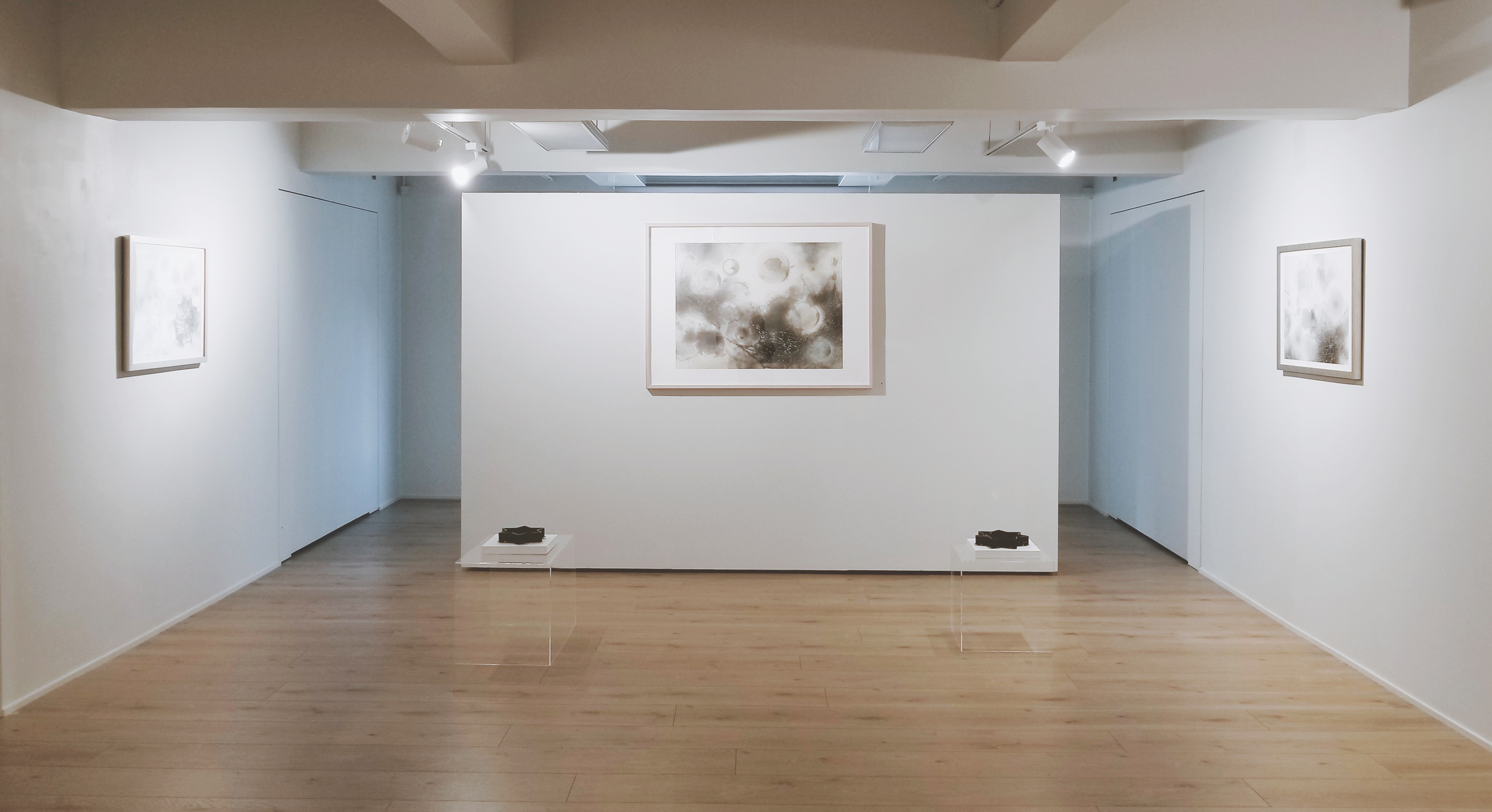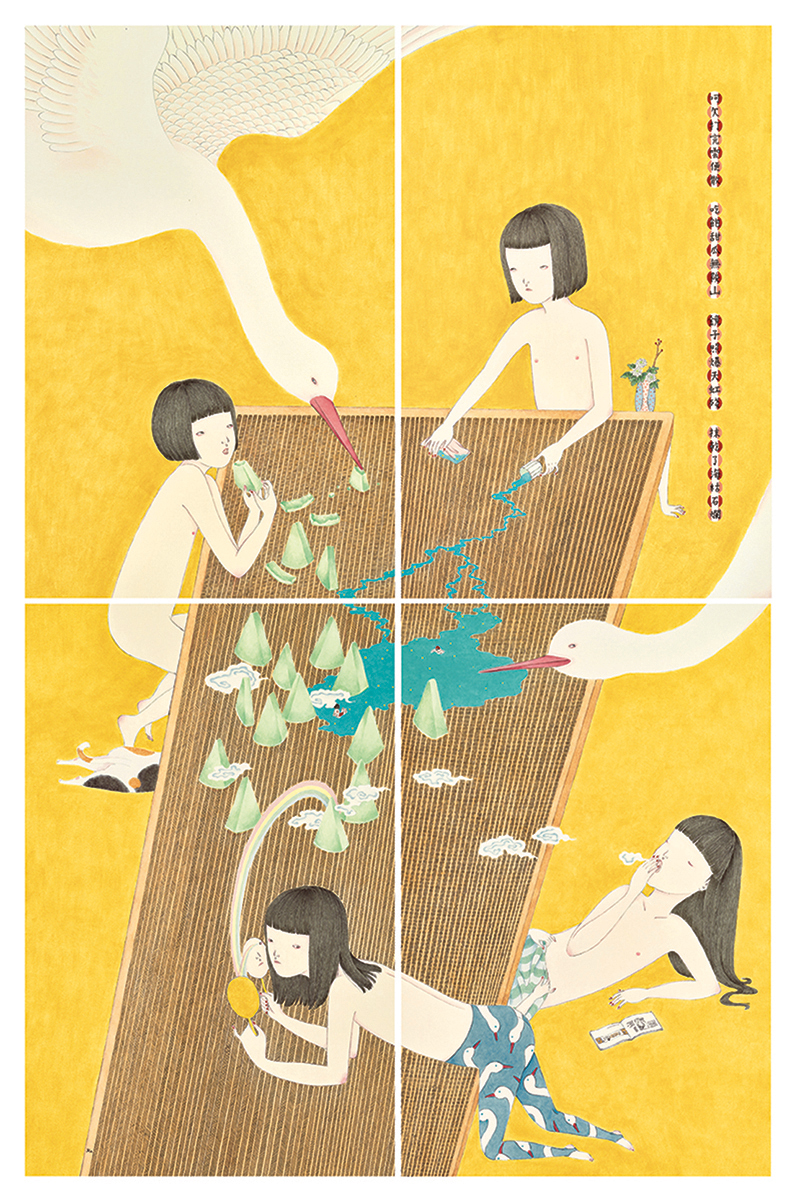Shows
“The Strangeness of Her Narratives”


“The Strangeness of Her Narratives” at Rossi & Rossi’s Hong Kong space presented the works of four Hong Kong female contemporary artists—Zaffer Chan, Eastman Cheng, Joey Leung and Wong Yeeki. Curated by Alexandra Choa, the show was supposedly centered on the notion of play, reflecting various artistic approaches to expressions of freedom, joy and escape.
The exhibition was arranged into four sections. Greeting the viewer was a combination of works on paper by Leung and Wong, as well as mixed-media installations created by the collective Cold Ears Factory (composed of Leung and Cheng). Leung’s Fragments of Time (2017) adopts the elaborate brushwork and motifs of archaic gongbi (a highly detailed and precise realist genre in Chinese painting) to depict a vibrantly colored fantasy world. Against a background of bright yellow is a composition of four girls gathered around a table, engaged in various relaxing activities, such as eating or reclining on the floor, while a pair of cranes—an auspicious symbol in Chinese painting and literature—intrude into the frame. Pieces of melon being eaten by one girl and water poured on the table by another form a surreal miniature lake and mountains, playfully turning these classic motifs from Chinese landscape painting into ordinary objects subjected to human action.

Cold Ears Factory similarly explored modern interpretations of ancient art forms with “Hard and Soft Sculpture” (2012– ). The series comprises handcrafted ceramic and fabric sculptures of flowers, shoes, and tiny human and animal figures, each of which is accompanied by a printed photograph of a plant that inspired the design of the sculpture. This display attempts to offer multiple representations of the elegant botanical motif, which is popular in both Chinese painting and porcelain. The slightly irregular, handmade style of the porcelain presents an interesting divergence from the tidy brushwork of Leung’s Fragments, although there is a distinct similarity in their childlike style.
Following the first section were independent exhibition zones for Chan and Wong. Capturing the intangible essence of dreams and memory through bubbles rendered with ink and soap and the recurring motif of the spiderweb, Chan’s “Dreamcatcher” series (2018) releases brush techniques of Chinese painting from depictions of antique subjects such as mountains and water. Instead of allowing the colors to spread freely across the paper, the artist carefully arranges the density and shapes of brushwork, creating a delicate and disciplined effect. Chan’s investigations into ink and brush painting continue in “Polaris” (2018), in which constellations are rendered in gloss golden ink on dark sheets that are positioned vertically in the shape of folding screens. Unfortunately, the visual impact of “Polaris” was muted compared with the “Dreamcatcher” paintings due to its small scale and below-eye-level placement.
The most intriguing work was Cheng’s video installation Encouragement (2016–18). Separated from the rest of the exhibition in a dark room, Encouragement provoked a distinct discourse other than the poetic fantasy prevalent in preceding works. In the video, the artist “paints” her nails with bogus nail varnish made of cloth while sounds or tunes from different countries play in the background. For example, Cheng paints her nails in primary colors of the Chinese national flag with the background audio of “Ode to the Motherland,” a famous communist anthem in China from the 1950s. Cheng seems to reject the historical narrative embedded in this song by converting nationalism to an accessory like nail varnish.
“The Strangeness of Her Narratives” highlighted a group of Hong Kong artists who present multiple angles from which to engage with Chinese painting in a contemporary context, yet despite the wide spectrum of artistic expression, the works exhibited hardly broke through the stereotypical aesthetic aims of archaic Chinese art. With the exception of Cheng’s video, the exhibits gave the impression of being limited to the pursuit of refined forms, whether through meticulous gongbi-inspired brushwork or elegant ink-rendering, leaving the viewer scarce space to play freely with the artists’ marginally strange narratives.
Dennis Mao is an editorial intern of ArtAsiaPacific.
“The Strangeness of Her Narratives” is on view at Rossi & Rossi, Hong Kong, until September 8, 2018.







